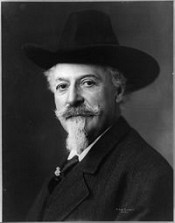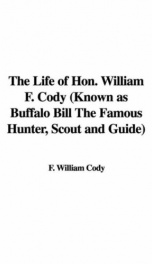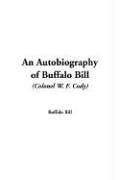Buffalo Bill

William Frederick "Buffalo Bill" Cody (February 26, 1846 – January 10, 1917) was an American soldier, bison hunter and showman. He was born in the Iowa Territory (now the American state of Iowa), near Le Claire. He was one of the most colorful figures of the American Old West, and mostly famous for the shows he organized with cowboy themes. Buffalo Bill received the Medal of Honor in 1872. William Frederick ("Buffalo Bill") got his nickname after he undertook a contract to supply Kansas Pacific Railroad workers with buffalo meat. The nickname originally referred to Bill Comstock.[1] Cody earned the nickname by killing 4,860 American Bison (commonly known as buffalo) in eight months (1867-68).[2] He and Comstock eventually competed in a shooting match over the exclusive right to use the name, which Cody won.[1] In addition to his documented service as a soldier during the Civil War and as Chief of Scouts for the Third Cavalry during the Plains Wars, Cody claimed to have worked many jobs, including as a trapper, bullwhacker, "Fifty-Niner" in Colorado, a Pony Express rider in 1860, wagonmaster, stagecoach driver, and even a hotel manager, but it's unclear which claims were factual and which were fabricated for purposes of publicity. He became world famous for his Wild West Shows.[3] While giving an anti-slavery speech at the local trading post, his father so inflamed the supporters of slavery in the audience that they formed a mob and one of them stabbed him. Cody helped to drag his father to safety, although he never fully recovered from his injuries. The family was constantly persecuted by the supporters of slavery, forcing Isaac Cody to spend much of his time away from home. His enemies learned of a planned visit to his family and plotted to kill him on the way. Cody, despite his youth and the fact that he was ill, rode 30 miles (48 km) to warn his father. Cody's father died in 1857 from complications from his stabbing.[4] After his father's death, the Cody family suffered financial difficulties, and Cody, aged 11, took a job with a freight carrier as a "boy extra," riding up and down the length of a wagon train, delivering messages. From here, he joined Johnston's Army as an unofficial member of the scouts assigned to guide the Army to Utah to put down a falsely-reported rebellion by the Mormon population of Salt Lake City.[4] According to Cody's account in Buffalo Bill's Own Story, the Utah War was where he first began his career as an "Indian fighter". Presently the moon rose, dead ahead of me; and painted boldly across its face was the figure of an Indian. He wore the war-bonnet of the Sioux, at his shoulder was a rifle pointed at someone in the river-bottom 30 feet (9 m) below; in another second he would drop one of my friends. I raised my old muzzle-loader and fired. The figure collapsed, tumbled down the bank and landed with a splash in the water. 'What is it?' called McCarthy, as he hurried back. 'It's over there in the water,'. 'Hi!' he cried. 'Little Billy's killed an Indian all by himself!' So began my career as an Indian fighter. At the age of 14, Cody was struck by gold fever, but on his way to the gold fields, he met an agent for the Pony Express. He signed with them and after building several way stations and corrals was given a job as a rider, which he kept until he was called home to his sick mother's bedside.[2] After his mother recovered Cody wished to enlist as a soldier, but was refused for his age. He began working with a United States freight caravan which delivered supplies to Fort Laramie. In 1863 he enlisted as a teamster with the rank of Private in Company H, 7th Kansas Cavalry and served until discharged in 1865.[4][2] From 1868 until 1872 Cody was employed as a scout by the United States Army. Part of this time he spent scouting for Indians, and the remainder was spent gathering and killing bison for them and the Kansas Pacific Railroad. In January 1872 Cody was a scout for Grand Duke Alexei Alexandrovich of Russia's highly publicized royal hunt.[5] Cody received a Medal of Honor in 1872 for "gallantry in action" while serving as a civilian scout for the 3rd Cavalry Regiment. In 1917, the U.S.Congress—after revising the standards for award of the medal—revoked 911 medals previously awarded either to civilians, or for actions that would not warrant a Medal of Honor under the new higher standards. After Dr. Mary Edwards Walker's medal was restored in 1977, other reviews began that led to Cody's medal—along with those given to four other civilian scouts—being re-instated on June 12, 1989.[6][7] In December 1872 Cody traveled to Chicago to make his stage debut with friend Texas Jack Omohundro in The Scouts of the Prairie, one of the original Wild West shows produced by Ned Buntline.[8] During the 1873-74 season, Cody and Omohundro invited their friend James Butler "Wild Bill" Hickok to join them in a new play called Scouts of the Plains.[9] The troupe toured for ten years and his part typically included an 1876 incident at the Warbonnet Creek where he claimed to have scalped a Cheyenne warrior, purportedly in revenge for the death of George Armstrong Custer.[10][11] It was the age of great showmen and traveling entertainers. Cody put together a new traveling show based on both of those forms of entertainment. In 1883 in the area of North Platte, Nebraska he founded "Buffalo Bill's Wild West," (despite popular misconception, the word "show" was not a part of the title) a circus-like attraction that toured annually.[3] In 1893 the title was changed to "Buffalo Bill's Wild West and Congress of Rough Riders of the World". The show began with a parade on horseback, with participants from horse-culture groups that included US and other military, American Indians, and performers from all over the world in their best attire. There were Turks, Gauchos, Arabs, Mongols and Georgians, among others, each showing their own distinctive horses and colorful costumes. Visitors to this spectacle could see main events, feats of skill, staged races, and sideshows. Many authentic western personalities were part of the show. For example Sitting Bull and a band of twenty braves appeared. Cody's headline performers were well known in their own right. People like Annie Oakley and her husband Frank Butler put on shooting exhibitions along with the likes of Gabriel Dumont. Buffalo Bill and his performers would re-enact the riding of the Pony Express, Indian attacks on wagon trains, and stagecoach robberies. The show typically ended with a melodramatic re-enactment of Custer's Last Stand in which Cody himself portrayed General Custer.[3] The profits from his show enabled him to purchase a 4,000-acre (16 km2) ranch near North Platte, Nebraska in 1886. Scout's Rest Ranch included an eighteen-room mansion and a large barn for winter storage of the show's livestock. In 1887 he took the show to Britain in celebration of the Jubilee year of Queen Victoria. The show was staged in London before going on to Birmingham and then Salford near Manchester, where it stayed for five months.[12] In 1889 the show toured Europe. In 1890 he met Pope Leo XIII. He set up an exhibition near the Chicago World's Fair of 1893, which greatly contributed to his popularity, and also vexed the promoters of the fair. As noted in The Devil in the White City, he had been rebuffed in his request to be part of the fair, so he set up shop just to the west of the fairgrounds, drawing many of their patrons away. Since his show was not part of the fair, he was not obligated to pay the promoters any royalties, which they could have used to temper their financial problems. Larry McMurtry, along with some historians such as RL Wilson, asserts that at the turn of the 20th century Buffalo Bill Cody was the most recognizable celebrity on earth.[3] And yet, despite all of the recognition and appreciation Cody's show brought for the Western and American Indian cultures, Buffalo Bill saw the American West change dramatically during his tumultuous life. Bison herds, which had once numbered in the millions, were now threatened with extinction. Railroads crossed the plains, barbed wire, and other types of fences divided the land for farmers and ranchers, and the once-threatening Indian tribes were now almost completely confined to reservations. Wyoming's resources of coal, oil and natural gas were beginning to be exploited towards the end of his life.[3] Even the Shoshone River was dammed for hydroelectric power as well as for irrigation. In 1897 and 1899 Cody and his associates acquired from the State of Wyoming the right to take water from the Shoshone River to irrigate about 169,000 acres (680 km2) of land in the Big Horn Basin. They began developing a canal to carry water diverted from the river, but their plans did not include a water storage reservoir. Cody and his associates were unable to raise sufficient capital to complete their plan. Early in 1903 they joined with the Wyoming Board of Land Commissioners in urging the federal government to step in and help with irrigation development in the valley. The Shoshone Project became one of the first federal water development projects undertaken by the newly formed Reclamation Service, later to become known as the Bureau of Reclamation. After Reclamation took over the project in 1903, investigating engineers recommended constructing a dam on the Shoshone River in the canyon west of Cody. Construction of the Shoshone Dam started in 1905, a year after the Shoshone Project was authorized. Almost three decades after its construction, the name of the dam and reservoir was changed to Buffalo Bill Dam by an act of Congress to honor Cody. In 1895, William Cody was instrumental in the founding of Cody, the seat of Park County in northwestern Wyoming. The site where the community was established is now the Old Trail Town museum, which honors the traditions of Western life. Cody first passed through the region in the 1870s. He was so impressed by the development possibilities from irrigation, rich soil, grand scenery, hunting, and proximity to Yellowstone Park that he returned in the mid-1890s to start a town. He brought with him men whose names are still on street signs in Cody’s downtown area – Beck, Alger, Rumsey, Bleistein and Salsbury. The town was incorporated in 1901.
do you like this author?
What readers are saying
What do you think? Write your own comment on this book!
write a commentWhat readers are saying
What do you think? Write your own comment on this author!
write a commentBook list

The Life of Hon. William F. CodyKnown as Buffalo Bill the Famous Hunter,Scout and Guide
Series:
Unknown
Year:
Unknown
Raiting:
5/5
Show more
add to favoritesadd In favorites

Story of the Wild West and Camp-fire Chats, by Buffalo Bill, (Hon. W. F. Cody.): A Full and ...
Series:
Unknown
Year:
Unknown
Raiting:
4/5
Book digitized by Google from the library of the University of Michigan and uploaded to the Internet Archive by user tpb.
Show more
add to favoritesadd In favorites

The Life of Hon. William F. Cody
Series:
Unknown
Year:
Unknown
Raiting:
4.5/5
William Frederick Cody, or "Buffalo Bill", wrote 3 books, two being autobiographic. One of them, “The Life of Hon. William F. Cody”, relates of his life, beginning from birth in 1846 until his thirty-fourth year-the years during which he grew up on the plains; and adventures, appearing more romantic than realistic. Nevertheless, it is a truthful, verified contribution to the records of our Western frontier history. Cody, being acquainted with numerous noted plainsmen not by hearsay, describes lots of interesting incidents and thrilling events connected with them.
Show more
add to favoritesadd In favorites
Book list

The Life of Hon. William F. CodyKnown as Buffalo Bill the Famous Hunter,Scout and Guide
Series:
Unknown
Year:
Unknown
Raiting:
5/5
Show more
add to favoritesadd In favorites

Story of the Wild West and Camp-fire Chats, by Buffalo Bill, (Hon. W. F. Cody.): A Full and ...
Series:
Unknown
Year:
Unknown
Raiting:
4/5
Book digitized by Google from the library of the University of Michigan and uploaded to the Internet Archive by user tpb.
Show more
add to favoritesadd In favorites

The Life of Hon. William F. Cody
Series:
Unknown
Year:
Unknown
Raiting:
4.5/5
William Frederick Cody, or "Buffalo Bill", wrote 3 books, two being autobiographic. One of them, “The Life of Hon. William F. Cody”, relates of his life, beginning from birth in 1846 until his thirty-fourth year-the years during which he grew up on the plains; and adventures, appearing more romantic than realistic. Nevertheless, it is a truthful, verified contribution to the records of our Western frontier history. Cody, being acquainted with numerous noted plainsmen not by hearsay, describes lots of interesting incidents and thrilling events connected with them.
Show more
add to favoritesadd In favorites

An Autobiography of Buffalo Bill (Colonel W. F. Cody)
Series:
Unknown
Year:
Unknown
Raiting:
1.5/5
An autobiographical work of William Frederick Cody, better known as "Buffalo Bill". He was an American soldier, bison hunter, army scout, an Indian fighter and showman of the nineteenth-twentieth centuries. It was Cody, who helped create the prototype "Wild West" hero.
Show more
add to favoritesadd In favorites
What readers are saying
What do you think? Write your own comment on this author!
write a commentif you like Buffalo Bill try:
readers also enjoyed
What readers are saying
What do you think? Write your own comment on this author!
write a commentif you like Buffalo Bill try:
readers also enjoyed
Do you want to exchange books? It’s EASY!
Get registered and find other users who want to give their favourite books to good hands!

